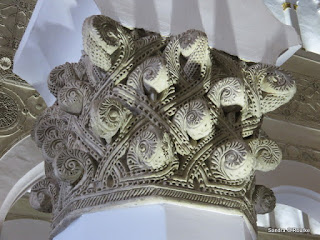Today is Sunday, September 23, 2018, we are touring Toledo, a city of three cultures. Christian, Muslim, and Jewish
According
to Wikipedia, “Toledo was declared a World Heritage Site by UNESCO in 1986 for
its extensive cultural and monumental heritage as one of the former capitals of
the Spanish Empire and place of coexistence of Christian, Jewish, and Muslim
cultures, as well as the place where harsh religious persecutions were held
against the Jews by the Visigoths.”
Toledo is an ancient city set on a hill above the plains of Castilla-La Mancha in central Spain.
The Tagus River runs through it
The Alcántara is a Roman arch bridge in Toledo, Spain, spanning the Tagus River.
Entering the Old Jewish Quarter
The borders of its Jewish Quarter are marked with blue and white tiles with a menorah and other symbols among the cobblestones.
The narrow streets of the Jewish Quarter
The major highlight of the Jewish Quarter for me was the synagogue of Santa Maria la Blanca
Photo provided by Wikipedia
White archways with decorative stone.
Beautiful Moorish architecture
Elaborate tile floors
Decorative columns
The synagogue had a very peaceful feeling,
We left the Jewish Quarter and visited the Toledo Cathedral, a Roman Catholic Church, the building began in 1227, completed in 1493.
The cathedral of Toledo is built in 13th Century high gothic style.
The narrow streets of Toledo
The retable of the Cathedral of Toledo is an extremely florid Gothic altarpiece; it is one of the last examples of this artistic style, which was disappearing as the Renaissance began to take hold in Spain. (Wikipedia)
St. Tomi Church - This church houses El Greco's masterpiece, the original painting of the Burial of Count Orgaz, one of El Greco's crowning achievements
The Entrance to the viewing of El Greco's masterpiece
El Greco, Burial of the Count Orgaz (1586-1588)
Local craftsman, working on an armor piece
This is the Don Quixote region of Spain




































No comments:
Post a Comment
Thank for you for your comment!